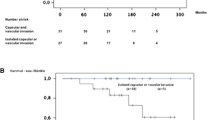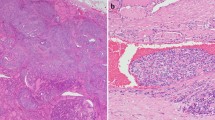Abstract
Some studies have reported that minimally invasive follicular carcinoma (MIFC) with vascular invasion is associated with compromised prognosis, leading to an ongoing debate regarding extent of surgery for MIFC. Our goal was to identify predictors of vascular invasion and determine its impact on patterns of care. Adult patients with MIFC were culled from the National Cancer Database, 2010–2011, and segregated according to the presence/absence of capsular or vascular invasion. Variables of interest were examined using Chi-square and student’s t tests. Multivariate analysis was performed with logistic regression. A total of 617 patients with MIFC were identified: 54 % with capsular invasion only and 46 % with vascular invasion. Demographic characteristics were similarly distributed between the two groups. Tumor size was larger in patients with vascular invasion (mean = 35.7 vs. 29.2 mm capsular invasion only, p < 0.001); a 2 % increase in risk of vascular invasion was observed with each 1 mm increase in size. The rate of total thyroidectomy was similar for MIFCs with vascular invasion compared to capsular invasion only (72.9 vs. 75.1 %, p = 0.537). The RAI administration rate was higher in patients with vascular invasion (62.1 vs. 52.6 % capsular invasion only, p = 0.017). In multivariate analysis, the presence of vascular invasion was independently associated with increased likelihood of receiving RAI (OR 1.641, p = 0.007). MIFC remains aggressively treated despite current guidelines favoring a more conservative approach. Building consensus around MIFC management is important for standardization of practice patterns and improvement in quality of care.

Similar content being viewed by others
References
C.E. Hedinger, E.D. Williams, L.H. Sobin, Histological typing of thyroid tumours, International Histological Classification of Tumours, vol. 11 (Springer, Berlin, 1988)
C.C. Huang, C. Hsueh, F.H. Liu, T.C. Chao, J.D. Lin, Diagnostic and therapeutic strategies for minimally and widely invasive follicular thyroid carcinomas. Surg. Oncol. 20(1), 1–6 (2011). doi:10.1016/j.suronc.2009.06.006
A. D’Avanzo, P. Treseler, P.H. Ituarte, M. Wong, L. Streja, F.S. Greenspan, A.E. Siperstein, Q.Y. Duh, O.H. Clark, Follicular thyroid carcinoma: histology and prognosis. Cancer 100(6), 1123–1129 (2004). doi:10.1002/cncr.20081
R. Ghossein, Update to the College of American Pathologists reporting on thyroid carcinomas. Head Neck Pathol 3(1), 86–93 (2009). doi:10.1007/s12105-009-0109-2
M.L. Carcangiu, Minimally invasive follicular carcinoma. Endocr Pathol 8(3), 231–234 (1997)
C.S. Heffess, L.D. Thompson, Minimally invasive follicular thyroid carcinoma. Endocr Pathol 12(4), 417–422 (2001)
Z.W. Baloch, V.A. LiVolsi, Follicular-patterned afflictions of the thyroid gland: reappraisal of the most discussed entity in endocrine pathology. Endocr Pathol 25(1), 12–20 (2014). doi:10.1007/s12022-013-9293-4
J. Rosai, M.L. Carcangiu, R.A. DeLellis, Tumours of the thyroid gland, Atlas of Tumor Pathology, vol. 3, Fascicle 5 (Armed Forces Institute of Pathology, Washington, 1992), pp. 49–63
B.H. Lang, C.Y. Lo, W.F. Chan, K.Y. Lam, K.Y. Wan, Staging systems for follicular thyroid carcinoma: application to 171 consecutive patients treated in a tertiary referral centre. Endocr. Relat. Cancer 14(1), 29–42 (2007). doi:10.1677/erc.1.01284
J.A. van Heerden, I.D. Hay, J.R. Goellner, D. Salomao, J.R. Ebersold, E.J. Bergstralh, C.S. Grant, Follicular thyroid carcinoma with capsular invasion alone: a nonthreatening malignancy. Surgery 112(6), 1130–1136 (1992). discussion 1136–1138
L.D. Thompson, J.A. Wieneke, E. Paal, R.A. Frommelt, C.F. Adair, C.S. Heffess, A clinicopathologic study of minimally invasive follicular carcinoma of the thyroid gland with a review of the English literature. Cancer 91(3), 505–524 (2001)
Z.W. Baloch, V.A. Livolsi, Follicular-patterned lesions of the thyroid: the bane of the pathologist. Am. J. Clin. Pathol. 117(1), 143–150 (2002). doi:10.1309/8vl9-ecxy-nvmx-2rqf
Y. Ito, M. Hirokawa, H. Masuoka, T. Yabuta, M. Kihara, T. Higashiyama, Y. Takamura, K. Kobayashi, A. Miya, A. Miyauchi, Prognostic factors of minimally invasive follicular thyroid carcinoma: extensive vascular invasion significantly affects patient prognosis. Endocr. J. 60(5), 637–642 (2013)
M. Hermann, K. Tonninger, F. Kober, E.M. Furtlehner, A. Schultheis, N. Neuhold, Minimally invasive follicular thyroid carcinoma : Not always total thyroidectomy. Chirurg. 81(7), 627–630, 632–625 (2010). doi:10.1007/s00104-009-1884-8
P. Goffredo, K. Cheung, S.A. Roman, J.A. Sosa, Can minimally invasive follicular thyroid cancer be approached as a benign lesion?: a population-level analysis of survival among 1200 patients. Ann. Surg. Oncol. 20(3), 767–772 (2013). doi:10.1245/s10434-012-2697-4
S.D. Kachare, J. Brinkley, J.H. Wong, N.A. Vohra, E.E. Zervos, T.L. Fitzgerald, The influence of sentinel lymph node biopsy on survival for intermediate-thickness melanoma. Ann. Surg. Oncol. (2014). doi:10.1245/s10434-014-3954-5
A.R. Shaha, Invited commentary: minimally invasive follicular thyroid carcinoma. Surgery 130(1), 119–120 (2001). doi:10.1067/msy.2001.115363
C.J. O’Neill, L. Vaughan, D.L. Learoyd, S.B. Sidhu, L.W. Delbridge, M.S. Sywak, Management of follicular thyroid carcinoma should be individualised based on degree of capsular and vascular invasion. Eur J Surg Oncol 37(2), 181–185 (2011). doi:10.1016/j.ejso.2010.11.005
K. Sugino, K. Kameyama, K. Ito, M. Nagahama, W. Kitagawa, H. Shibuya, K. Ohkuwa, Y. Yano, T. Uruno, J. Akaishi, A. Suzuki, C. Masaki, K. Ito, Outcomes and prognostic factors of 251 patients with minimally invasive follicular thyroid carcinoma. Thyroid 22(8), 798–804 (2012). doi:10.1089/thy.2012.0051
E.J. Ban, A. Andrabi, S. Grodski, M. Yeung, C. McLean, J. Serpell, Follicular thyroid cancer: minimally invasive tumours can give rise to metastases. ANZ J Surg 82(3), 136–139 (2012). doi:10.1111/j.1445-2197.2011.05979.x
L. Delbridge, R. Parkyn, J. Philips, B. Barraclough, B. Robinson, Minimally invasive follicular thyroid carcinoma: completion thyroidectomy or not? ANZ J Surg 72(11), 844–845 (2002)
K. Sugino, K. Kameyama, M. Nagahama, W. Kitagawa, H. Shibuya, K. Ohkuwa, T. Uruno, J. Akaishi, A. Suzuki, C. Masaki, K. Matsuzu, M. Kawano, K. Ito, Does completion thyroidectomy improve the outcome of patients with minimally invasive follicular carcinoma of the thyroid? Ann. Surg. Oncol. 21(9), 2981–2986 (2014). doi:10.1245/s10434-014-3734-2
American College of Surgeon: National Cancer Data Base (2015). https://www.facs.org/quality%20programs/cancer/ncdb. Accessed 1 March 2015
A. Fritz, C. Percy, A. Jack, K. Shanmugarathnam, L. Sobin, D.M. Parkin, S. Whelan, International Classification of Disease for Oncology, vol. 3 (World Health Organization, Geneva, 2000)
B.A. Williams, J.N. Mandrekar, S.J. Mandrekar, S.S. Cha, A.F. Furth, Division of Biostatistics, Finding optimal cutpoints for continuous covariates with binary and time-to-event outcomes (Mayo Clinic, Rochester, 2006)
National Cancer Institute: Staging information for thyroid cancer (2015). http://www.cancer.gov/cancertopics/pdq/treatment/thyroid/HealthProfessional/page1/AllPages. Accessed May 12 2015
H.J. Kim, J.Y. Sung, Y.L. Oh, J.H. Kim, Y.I. Son, Y.K. Min, S.W. Kim, J.H. Chung, Association of vascular invasion with increased mortality in patients with minimally invasive follicular thyroid carcinoma but not widely invasive follicular thyroid carcinoma. Head Neck (2013). doi:10.1002/hed.23511
D.S. Cooper, G.M. Doherty, B.R. Haugen, R.T. Kloos, S.L. Lee, S.J. Mandel, E.L. Mazzaferri, B. McIver, F. Pacini, M. Schlumberger, S.I. Sherman, D.L. Steward, R.M. Tuttle, Revised American Thyroid Association management guidelines for patients with thyroid nodules and differentiated thyroid cancer. Thyroid 19(11), 1167–1214 (2009). doi:10.1089/thy.2009.0110
NCCN Thyroid Carcinoma Guidelines. (2014). Accessed August 27 2014
G. Dionigi, J.L. Kraimps, K.W. Schmid, M. Hermann, S.Y. Sheu-Grabellus, P. De Wailly, A. Beaulieu, M.L. Tanda, F. Sessa, Minimally invasive follicular thyroid cancer (MIFTC)—a consensus report of the European Society of Endocrine Surgeons (ESES). Langenbecks Arch. Surg. 399(2), 165–184 (2014)
D.P. Winchester, A.K. Stewart, J.L. Phillips, E.E. Ward, The national cancer data base: past, present, and future. Ann. Surg. Oncol. 17(1), 4–7 (2010). doi:10.1245/s10434-009-0771-3
Acknowledgments
Paolo Goffredo was supported by the Fondazione Italiana per la Ricerca sul Cancro—FIRC (Italian Foundation for Cancer Research).
Conflict of interest
The authors have nothing to declare.
Author information
Authors and Affiliations
Corresponding author
Additional information
The data used in this study are derived from a de-identified National Cancer Data Base (NCDB) file.
Rights and permissions
About this article
Cite this article
Goffredo, P., Jillard, C., Thomas, S. et al. Minimally invasive follicular carcinoma: predictors of vascular invasion and impact on patterns of care. Endocrine 51, 123–130 (2016). https://doi.org/10.1007/s12020-015-0649-z
Received:
Accepted:
Published:
Issue Date:
DOI: https://doi.org/10.1007/s12020-015-0649-z




